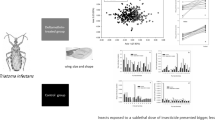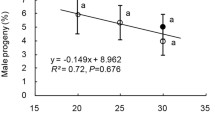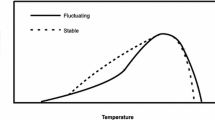Abstract
Insecticide resistance is an evolutionary response of specific insect populations subjected to exposure and consequent selection by an insecticide. As such, this phenomenon is important as a biomonitoring strategy and also has economical importance in the case of insect-pests by compromising their control. Fluctuating asymmetry (FA) of bilateral traits is a measure of developmental instability also suggested as a monitoring tool for environmental pollution with potential consequences for fitness. Responses to selective agents might have pleiotropic effects influencing development and phenotype, which has yet to be examined for agricultural insecticides and insect-pests. Higher levels of FA are expected in the insecticide-resistant strains, which are usually at a selective disadvantage, relative to susceptible strains, in the absence of the insecticide. Two insecticide-resistant strains and an insecticide-susceptible strain of the maize pest insect Sitophilus zeamais (Coleoptera: Curculionidae) were subjected to FA measurements in 12 traits of wing veins and tibias of 100 individuals of both sexes of each strain. The insecticide-resistant strains showed lower FA than the susceptible strain, in contrast with the initial expectation. An extended period of insecticide selection probably led to the evolution of fitness-modifier genes improving the performance of the resistant genotypes, reducing their FA levels, and leading to their eventual fixation in the population. In addition, one insecticide-resistant strain and the insecticide-susceptible strain showed significant differences in FA between sexes, with more symmetrical males suggesting possible sexual selection by the females. The observed results have potential consequences for insecticide-resistance evolution and dispersal.


Similar content being viewed by others
References
Antipin MI, Imasheva AG (2001) Genetic variability and fluctuating asymmetry of morphological traits in Drosophila melanogaster reared on a pesticide-containing medium. Rus J Genet 37:247–252
Arnaud L, Haubruge E (2002) Insecticide resistance enhances male reproductive success in a beetle. Evolution 56:2435–2444
Berticat C, Boquien G, Raymond M, Chevillon C (2002) Insecticide resistance genes induce a mating competition cost in Culex pipiens mosquitoes. Gen Res 79:41–47
Clarke GM, Yen JL, McKenzie JA (2000) Wings and bristles: character specificity of the asymmetry phenotype in insecticide-resistant strains of Lucilia cuprina. Proc R Soc London B 267:1815–1818
Coustau C, Chevillon C, French-Constant R (2000) Resistance to xenobiotics and parasites: can we count the cost? Trends Ecol Evol 15:378–383
CSIRO (1991) The insects of Australia, 2nd ed. Melburne University Press, Carlton, Australia
Darwin C (1859) On the origin of species by means of natural selection. Murray, London
Fragoso DB, Guedes RNC, Oliveira MGA (2007) Partial characterization of glutathione S-transferases in pyrethroid-resistant and -susceptible populations of the maize weevil, Sitophilus zeamais. J Stored Prod Res 43:167–170
Fragoso DB, Guedes RNC, Peternelli LA (2005) Developmental rates and population growth of insecticide-resistant and susceptible populations of Sitophilus zeamais. J Stored Prod Res 41:271–281
Fragoso DB, Guedes RNC, Rezende ST (2003) Biochemical mechanisms of insecticide resistance in Brazilian populations of Sitophilus zeamais Motschulsky (Coleoptera: Curculionidae). Entomol Exp Appl 109:21–29
Guedes RNC (1991) Resistência a inseticidas: desafio para o controle de pragas de grãos armazenados. Seiva 50:24–29
Guedes RNC, Lima JOL, Santos JP, Cruz CD (1994) Inheritance of deltamethrin resistance in a Brazilian strain of maize weevil (Sitophilus zeamais Mots.). Int J Pest Manag 40:103–106
Guedes RNC, Lima JOL, Santos JP, Cruz CD (1995) Resistance to DDT and pyrethroids in Brazilian populations of Sitophilus zeamais Motsch. (Coleoptera: Curculionidae). J Stored Prod Res 31:145–150
Guedes RNC, Oliveira EE, Guedes NMP, Ribeiro B, Serrão JE (2006) Cost and mitigation of insecticide resistance in the maize weevil, Sitophilus zeamais. Physiol Entomol 31:30–38
Hardersen S (2000) Effects of carbaryl exposure on the last larval instar of Xanthocnemis zealandica: fluctuating asymmetry and adult emergence. Entomol Exp Appl 96:221–230
Hoffmann AA, Woods RE, Collins E, Wallin K, White A, McKenzie JA (2005) Wing shape versus asymmetry as an indicator of changing environmental conditions in insects. Aust J Entomol 44:233–243
Holloway GJ, Smith RH (1987) Sexual selection of body weight in Sitophilus oryzae (L.) (Coleoptera: Curculionidae). J Stored Prod Res 23:197–202
Hopkin SP (1998) In situ biological monitoring of pollution in terrestrial and aquatic ecosystems. In: Calow P (ed) Handbook of ecotoxicology. Blackwell, Oxford, pp 397–427
Hosken DJ (2001) Size and fluctuating asymmetry in sexually selected traits. Anim Behav 62:603–605
Knight AL, Norton GW (1989) Economics of agricultural pesticide resistance in arthropods. Annu Rev Entomol 34:293–313
Leamy LJ, Klingenberg CP (2005) The genetics and evolution of fluctuating asymmetry. Annu Rev Ecol Syst 36:1–21
Lens L, Van Dongen S, Kark S, Matthysen E (2002) Fluctuating asymmetry as an indicator of fitness: can we bridge the gap between studies? Biol Rev 77:27–38
Martynov AV (1930) The interpretation of the wing venation and tracheation of the Odonata and Agnatha. Psyche 37:245–280
Markow TA (1995) Evolutionary ecology and developmental instability. Annu Rev Entomol 40:105–120
McKenzie JA, Batterham P (1994) The genetic, molecular and phenotypic consequences of selection for insecticide resistance. Trends Ecol Evol 9:166–169
McKenzie JA, Clarke GM (1988) Diazinon resistance, fluctuating asymmetry and fitness in the Australian sheep blowfly, Lucilia cuprina. Genetics 120:213–220
McKenzie JA, O’Farrell K (1993) Modification of developmental instability and fitness: malathion-resistance in the Australian sheep blowfly, Lucilia cuprina. Genetica 89:67–76
Melander (1914) Can insects become resistant to sprays? J Econ Entomol 7:167–172
Møller AP (1997) Developmental stability and fitness: a review. Am Nat 149: 916–932
Møller AP, Swaddle JP (1997) Asymmetry, developmental stability, and evolution. Oxford University Press, Oxford
Møller AP, Thornhill R (1998) Bilateral asymmetry and sexual selection: a meta-analysis. Am Nat 151:174–192
Møller AP, Thornhill R, Gangestad SW (2005) Direct and indirect tests for publication bias: asymmetry and sexual selection. Anim Behav 70:497–506
Moriarty F (1999) Ecotoxicology: the study of pollutants in ecosystems, 3rd ed. Academic, London
Oliveira EE, Guedes RNC, Corrêa AS, Damasceno BL, Santos CT (2005) Resistência vs susceptibilidade a piretróides em Sitophilus zeamais Motschulsky (Coleoptera: Curculionidae): há vencedor? Neotrop Entomol 34:981–990
Palmer AR (1994) Fluctuating asymmetry analyses: a primer. In: Markow TA (ed) Developmental stability: Its origins and evolutionary implications. Kluwer, Dordrecht, pp 335–364
Palmer AR (1999) Detecting publication bias in meta-analysis: a case study of fluctuating asymmetry and sexual selection. Am Nat 154:220–233
Palmer AR, Strobeck C (1986) Fluctuating asymmetry: measurement, analysis, patterns. Annu Rev Ecol Syst 17:391–421
Palmer AR, Strobeck C (2003) Fluctuating asymmetry analyses revisited. In: Polak M (ed) Developmental instability: Causes and consequences. Oxford University Press, Oxford, pp 279–319
Parsons PA (2005) Environments and evolution: interactions between stress, resource inadequacy and energetic efficiency. Biol Rev 80:1–22
Rees DP (1996) Coleoptera. In: Bubramanyam BH, Hagstrum DW (eds) Integrated management of insects in stored products. Marcel Dekker, New York, pp 1–39
Ribeiro BM, Guedes RNC, Oliveira EE, Santos JP (2003) Insecticide resistance and synergism in Brazilian populations of Sitophilus zeamais (Coleoptera: Curculionidae). J Stored Prod Res 39:21–31
Roush RT, McKenzie JA (1987) Ecological genetics of insecticide and acaricide resistance. Annu Rev Entomol 32:361–380
SAS Institute (1997) SAS/STAT user’s guide. SAS, Cary, NC
Strong L, James S (1993) Some effects of ivermectin on the yellow dung fly, Scatophaga stercoraria. Vet Parasitol 48:181–191
USDA (1980) Stored-grain insects. ARS-USDA, Washington, DC
Van Dongen S, Talloen W, Lens L (2005) High variation in developmental instability under non-normal developmental error: a Bayesian perspective. J Theor Biol 236:263–275
Walker CH, Hopkin SP, Sibly RM, Peakall DB (2005) Evolution of resistance to pollution. In: Walker CH, Hopkin SP, Sibly RM, Peakall DB (eds) Principles of ecotoxicology, 3rd ed. CRC, London, p 344
Acknowledgments
The financial support provided by the Minas Gerais State Agency for Research Aid (FAPEMIG) and the National Council of Scientific and Technological Development (CNPq) was greatly appreciated.
Author information
Authors and Affiliations
Corresponding author
Rights and permissions
About this article
Cite this article
Ribeiro, B., Guedes, R.N.C., Corrêa, A.S. et al. Fluctuating Asymmetry in Insecticide-Resistant and Insecticide-Susceptible Strains of the Maize Weevil, Sitophilus zeamais (Coleoptera: Curculionidae). Arch Environ Contam Toxicol 53, 77–83 (2007). https://doi.org/10.1007/s00244-006-0162-8
Received:
Accepted:
Published:
Issue Date:
DOI: https://doi.org/10.1007/s00244-006-0162-8




